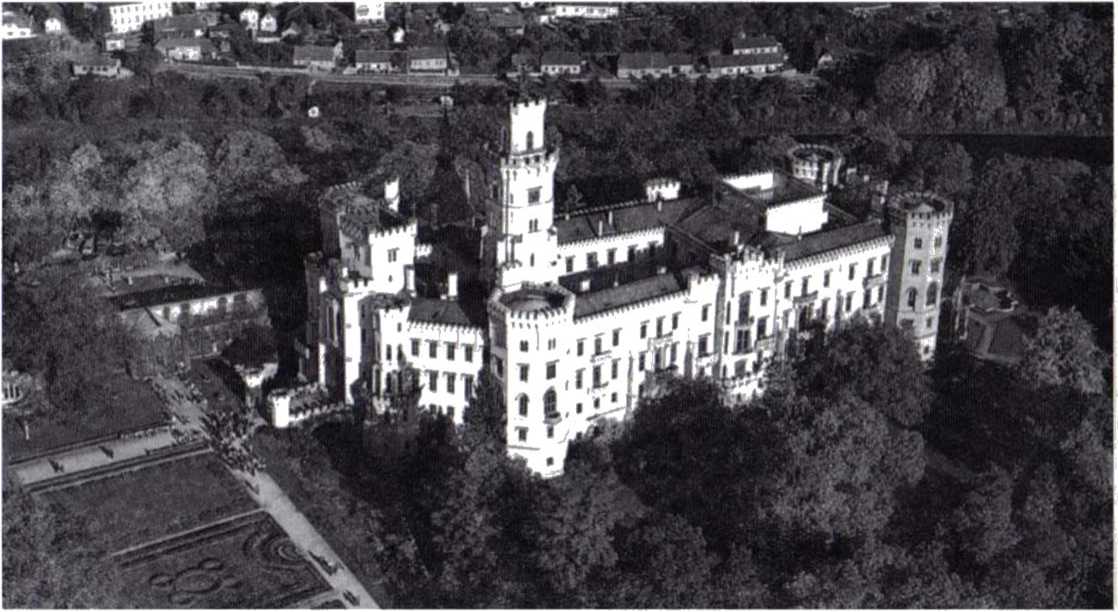img005 (54)


Schloss Hluboka
Oie Grundung der Burg wird dem Hofrictiter te von Budśjovice zugeschrieben, der dte Burg an Pfemysl Otakar II. abtrat, obwohl ihre ursprungliche Bezeichnung Fronburg (dte Burg des Herm) eher eine landesfurstliche Grundung bezeugt.
Hluboka trat erst im Jahre 1285 in die Geschichłe, ais Witiko. der Bruder von Zaviś von Falkenśtejn, der Oomane regierte Nachdem Zśvtś des Hoctwerrates beschuldigl wurde und Witiko lebnte es ab. Hluboka in die koniglichen Hande zu ubergeben, lieS der Troppauer Herzog WikulaS im Jahre 1290 Zśviś aut der sog. Słrafwiese vor Hluboka hinrichten.
Die Hluboka-Domane wurde dann oft verptandet und erholte stch erst wahrend der Regierung von Vilem von Pernśtejn. der die verkommene Burg sanieren lieB und bei Hlubotó eimge Teiche erbaute, unter ihnen auch den Bezdrev. Im Jahre 1561 kaufte Joachim von Hradec Hlubokś von der koniglichen Kammer ab. Die Bauanderungen. die durch seinen vorzeitigen Tod unterbrochen wurden, beendete erst sein Sohn Adam unter der Beteiligung des italienischen Baumeisters Baltazare Maggi, der die gotische Burg zu einem Renaissanceschloss mit zwei Schlosshófen umbaute.
Einen weiteren groGen baulichen Eingrift machte Hluboka am Anfang des 18. Jahrhunderts durch, ais Adam Franz von Schwarzenberg es nach dem Entwurf des lurstlichen Baumeisters Paul Ignaz Bayer grundlich umbauen liefi. Adam Franz erlebte jedoch die Baubeendigung nicht meht. 1732 wurde er vom Kaiser Karl VI. bei einer Jagd unglucklich erschossen.
Die heutige Gestalt erhielt Hluboka jedoch erst wahrend der Regierung von Johann Adolf II. von Schwarzenberg und seiner Gemahlin Eleonorę. Das furstliche Ehepaar machte sich bei seinen Reisen durch England mit der Architektur im Tudor-und elisabethanischen Stil bekannt. Besonders die Furstin war vom Kónigsschloss in Windsor so begeistert dass der Wiener Architekt Franz Beer nach ihrer Ruckkehr mit dem Umbau von Hluboka nach diesem Vorbild beauttragt wurde. Der Umbau vertief in den Jahren 1839-1871 und uberdeckte vóllig die vorherigen baulichen Etappen. Gleichzeitig mit dem Schlossumbau wurde die ausgedehnte Vorburg niedergenssen und ein englischer Park mil einem Wintergarten und die damit verbundene Reitschule wurden angelegt. Die Auswahl der Baume richtete sich nach der Verfarbung ihrer Blatter im Herbst. Westlich vom Schloss wurde im gleichen Stil ein Haus fur die Herrenbeamten erbaut. Unter den Schlossarealen aus der Zeit der Romantik gehórt das Schloss Hluboka mit dem gesamten Baukomplex und seiner feinsinnig komponierten Umgebung zu den besten in Mitteleuropa
Hluboka nad Vltavou Chateau
The lounding ot this castle is originally associated with the Ćeć elan, the tounders of the old town of Budćjovice, who ceded the castle to the Czech king Pfemysl Otakar II., even though its original name of Fronburg (Master s castle) attests to its probable establishment as an agricultura! estate.
Hluboka entered history in 1285 when the estate was ruled by Vitek, brother of Zaviś of Falkenśtejn. After Zaviś was accused of high treason, Vitek refused to hand Hluboka over to royal hands and the Duke of Opava Mikulaś had Zśviś executed in front of Hluboka, on the so-called "Penalty Field".
The Hluboka estates were often used afterwards for securities and pledges and slowly dilapidated, then were finally repaired by Vilem of Pernśtejn, who also had a series of lakes and ponds built around Hluboka, including the Bezdrev. In 1561 Jachym of Hradec bought Hluboka from the royal chamber. The building work he began was continued after his premature death by his son Adam with the participation of the Italian builder Baltazar Maggi, who reconstructed the Gothic castle into a Renaissance chateau around two courtyards.
The next reconstruction of Hluboka came at the beginning of the 18th century, when Adam Franz Schwarzenberg had the castle reconstructed from the foundations up according to a design by the court builder Pavel Ignac Bayer. Unfortunately, did not live to see the works accomplished. By accident, he was shot by Emperor Charles VI. during a hunt in 1732
Todays appearance, however, comes to us from the time of Johann Adolf II. of the Schwarzenberg family and his wife Eleonora. The princely pair often madę trips to England and became acquainted there with Tudorian and Elizabethan architecture. The princess especially was so charmed by the royal chateau of Windsor that upon their return the Viennese architect Franz Beer was commissioned to reconstruct Hlubokś based on its design. The works lasted from 1839 to 1871 and completely covered all traces of the preyious building phases. At the same time, the extensive area in front of the castle was demolished and an English park was installed with a Winter garden and adjacent riding school. On the west side of the castle a court administration building was constructed in the same style. Special attention was granted also to the design of the surrounding landscape. The park and the neighbouring areas were spaced with ridings and alleys, diversified by meadows with mighty solitary tree species selected by the colours of leaves in autumn,
With its complex of premises and carefully composed landscape, Hluboka belongs to the foremost chateau ranges from Romanticism era in Central Europę.
Wyszukiwarka
Podobne podstrony:
26436 P1170411 (2) Bodendcnkmałpflege in Mecklenburg, s. 61 83. 1972 Oie Fundę der
87426 ObrazC0 (3) OIE modę der italienischen renaissance Die Modę der Friihrenaissance In Italien, w
VW 6 ldentifizierungskatalog fiir KFZ VS-NfD 7 = Laufende ZahlzahlSitz der FIN: Grundsatzlich an der
d aaoor der Ul 211 an doli, me ll n/cis en car e nne autre maniero Canterumt darcie, car deJ (jut co
P1240337 54 Sta i o ale to pod wpływem współczesnych .1*3, używanych na zbliżony a
P2210357 54 Wstęp do historii filozofii poszczególna część liścia ma wszystkie te własności, jakie m
20 CRISTINA FENESAN 8 gleicher Zeit wird Nalieres iiber das von Martinuzzi bei Aufstellung der
więcej podobnych podstron